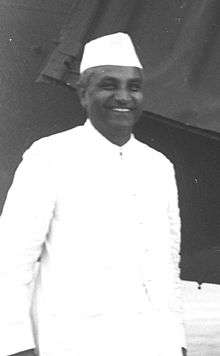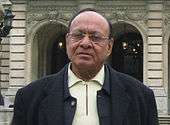Gujarat Pradesh Congress Committee
The Gujarat Pradesh Congress Committee (GPCC) is the unit of the Indian National Congress for the state of Gujarat.
Gujarat Pradesh Congress Committee | |
|---|---|
| President | Amit Chavda |
| Headquarters | Rajiv Gandhi Bhawan, Ahmedabad-380006, Gujarat |
| Youth wing | Gujarat Youth Congress |
| Women's wing | Gujarat Pradesh Mahila Congress Committee |
| Ideology | |
| Alliance | United Progressive Alliance |
| Seats in Lok Sabha | 0 / 26
|
| Seats in Rajya Sabha | 4 / 11
|
| Seats in Gujarat Legislative Assembly | 65 / 182
|
| Election symbol | |
 | |
| Website | |
| INC Gujarat Website | |
Amit Chavda is the president of GPCC and the working presidents are Hardik Patel, Dr. Tushar Chaudhary and Dr. Karsandas Soneri.[1]
History
It was formed in 1920 and its first and longest running president was Sardar Vallabhbhai Patel. The GPCC would organize Indian nationalist campaigns during the Indian freedom struggle, and after independence in 1947, it became responsible for supplying candidates of the Congress in local and state election campaigns.[2]
Office
Gujarat Pradesh Congress started functioning at Khamasa, Ahmedabad under leadership of Kantilal Ghiya, the first president.
In 1971, it was shifted to Shahpur and then to Hawawala Blocks on Ashram Road, Ahmedabad.
During 1977, it was again shifted to Khanpur, which till recently was Ahmedabad City Congress Committee (INC DCC Office). Subsequently to Vikram Chambers on Ashram Road.
Finally the place where Rajiv Bhawan stands at present was handed over to Congress by Hitendrabhai Desai. INC Gujarat is run from this premises, which was inaugurated on 28 December 2006 by Ahmedbhai Patel, Rajya Sabha MP.
Chief Ministers of Gujarat
| Colour key for parties |
|---|


| No[lower-alpha 1] | Name | Term of office[3] | Party[lower-alpha 2] | Days in office | Assembly[4] | Ref | ||
|---|---|---|---|---|---|---|---|---|
| 1 | Jivraj Narayan Mehta Amreli |
1 May 1960 | 3 March 1962 | Indian National Congress | 1238 days | First (1960–61) | [5] | |
| 3 March 1962 | 19 September 1963 | Second (1962–66) | [6] | |||||
| 2 | Balwantrai Mehta Bhavnagar |
19 September 1963 | 19 September 1965 | 733 days | ||||
| 3 | Hitendra Kanaiyalal Desai Olpad |
19 September 1965 | 3 April 1967 | 2062 days | ||||
| 3 April 1967 | 12 May 1971 | Indian National Congress (O) | Third (1967–71) | [7] | ||||
| – | Vacant[lower-alpha 3] (President's rule) |
13 May 1971 | 17 March 1972 | N/A | Dissolved | |||
| 4 | Ghanshyam Oza Dehgam |
17 March 1972 | 17 July 1973 | Indian National Congress | 488 days | Fourth (1972–74) | [9] | |
| 5 | Chimanbhai Patel Sankheda |
17 July 1973 | 9 February 1974 | 207 days | ||||
| – | Vacant[lower-alpha 3] (President's rule) |
9 February 1974 | 18 June 1975 | N/A | Dissolved | |||
| – | Vacant[lower-alpha 3] (President's rule) |
12 March 1976 | 24 December 1976 | N/A | ||||
| 7 | Madhav Singh Solanki Bhadran |
24 December 1976 | 10 April 1977 | Indian National Congress | 108 days | |||
| – | Vacant[lower-alpha 3] (President's rule) |
17 February 1980 | 6 June 1980 | N/A | Dissolved | |||
| (7) | Madhav Singh Solanki Bhadran |
7 June 1980 | 10 March 1985 | Indian National Congress | 1856 days | Sixth (1980–85) | [10] | |
| 11 March 1985 | 6 July 1985 | Seventh (1985–90) | [11] | |||||
| 8 | Amarsinh Chaudhary Vyara (ST) |
6 July 1985 | 9 December 1989 | 1618 days | ||||
| (7) | Madhav Singh Solanki Bhadran |
10 December 1989 | 3 March 1990 | 85 days (Total: 2049 days) | ||||
| 9 | Chhabildas Mehta Mahuva |
17 February 1994 | 13 March 1995 | Indian National Congress | 391 days | |||
| 11 | Suresh Mehta Mandvi |
21 October 1995 | 19 September 1996 | 334 days | ||||
| – | Vacant[lower-alpha 3] (President's rule) |
19 September 1996 | 23 October 1996 | N/A | ||||
| 12 | Shankersinh Vaghela Radhanpur |
23 October 1996 | 27 October 1997 | Rashtriya Janata Party | 370 days | |||
| 13 | Dilip Parikh Dhandhuka |
28 October 1997 | 4 March 1998 | 128 days | ||||
- A number inside brackets indicates that the incumbent has previously held office.
- This column only names the chief minister's party. The state government he headed may have been a complex coalition of several parties and independents; these are not listed here.
- President's rule may be imposed when the "government in a state is not able to function as per the Constitution", which often happens because no party or coalition has a majority in the assembly. When President's rule is in force in a state, its council of ministers stands dissolved. The office of chief minister thus lies vacant, and the administration is taken over by the governor, who functions on behalf of the central government. At times, the legislative assembly also stands dissolved.[8]
See also
References
- https://www.inc.in/en/pcc-presidents
- Jaffrelot, Christophe (10 October 2017). "The Congress in Gujarat (1917–1969): Conservative Face of a Progressive Party". Studies in Indian Politics. 5 (2): 248–261. doi:10.1177/2321023017727982.
- Chief Ministers of Gujarat. Gujarat Vidhan Sabha. Retrieved on 18 December 2012.
- List of Duration of Sessions (1 to 12 Vidhansabha) and sittings of Gujarat Legislative Assembly. Gujarat Vidhan Sabha. Retrieved on 18 December 2012.
- "Statistical Report on General Election, 1957, to the Legislative Assembly of Bombay". Election Commission of India. Retrieved on 23 May 2014.
- "Key Highlights of General Election, 1962, to the Legislative Assembly of Gujarat". Election Commission of India. Retrieved on 23 May 2014.
- "Key Highlights of General Election, 1967, to the Legislative Assembly of Gujarat". Election Commission of India. Retrieved on 23 May 2014.
- Amberish K. Diwanji. "A dummy's guide to President's rule". Rediff.com. 15 March 2005.
- "Key Highlights of General Election, 1972, to the Legislative Assembly of Gujarat". Election Commission of India. Retrieved on 23 May 2014.
- "Key Highlights of General Election, 1980, to the Legislative Assembly of Gujarat". Election Commission of India. Retrieved on 23 May 2014.
- "Key Highlights of General Election, 1985, to the Legislative Assembly of Gujarat". Election Commission of India. Retrieved on 23 May 2014.